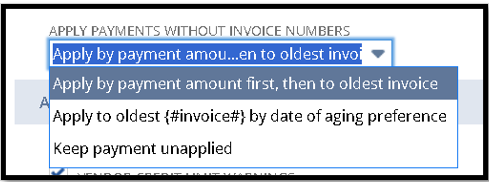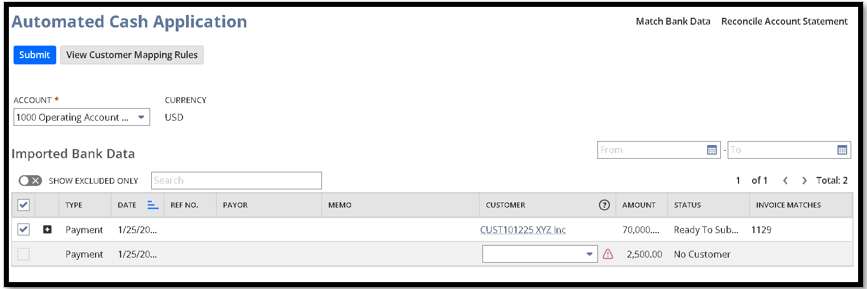NetSuite Cash Application: Simplify Finances with Automation
This article comprehensively examines NetSuite’s Automated Cash Application feature, covering its key benefits, matching algorithms, and acknowledged limitations. The Automated Cash Application tool streamlines the process by automatically aligning imported bank data with existing customers and open invoices in the NetSuite ERP system. Utilizing a customizable matching algorithm, the system ensures optimal match accuracy for both customers and invoices. Upon review and confirmation of matching results, the system automatically generates customer payments, applies them to specified invoices, and reconciles cash payments from bank statements.
Key Benefits
This tool is utilized by a wide range of businesses, spanning from small and mid-size enterprises to large-scale organizations. Its prevalence is especially notable in the global space, where businesses frequently handle substantial volumes of ACH, direct payment, and bank transfer transactions. Below are some key benefits of adopting an automated cash application tool:
- Streamlines the process of reconciling cash and creating/applying payments, saving valuable time
- Minimizes errors and user mistakes through systematic process automation
- Improves cash flow visibility by automatically generating payments, allowing for quicker fund utilization
- Lowers operating costs by increasing efficiency and reducing manual intervention
System Matching Algorithms
1.) Bank data can be imported directly from the bank or treasury system. Once in NetSuite, the system will automatically match the imported bank data with existing customers and invoices in the system. Below is the matching algorithm:
- It is an exact match if any of the following values from the imported bank file match a customer name or invoice number in NetSuite.
- Customer name
- Customer ID
- Invoice number or numbers
Note: If the bank line specifies invoice number but no customer name, the system will find the associated customer of that invoice. If the bank line just specifies the customer and no invoice number, the system will look at open invoices for that customer and try to match based on accounting preferences below.

- It is a preferred match if a customer mapping rule already exists in NetSuite and can be used to identify a customer. The rule must contain values similar enough to the Payor and Memo fields on the imported bank lines that NetSuite can identify the appropriate customer. When comparing rule values to bank lines, the system transforms the values by removing white space, numbers, special characters, and capitalization.
- It is a partial match if the bank line has a Payor or Memo value similar enough to a customer name that the system can identify that customer. The similarity algorithm uses both characters and word length to try to identify a customer to whom an imported bank line may belong. If the wrong customer is selected, which can occur if customers are too similarly named, user can select the right customer and create an associated mapping rule.
2.) Once system matching is complete, user can open the cash application page and review the matching results/make changes if needed:
- Once the relevant bank account is chosen on the page, NetSuite displays a list of imported bank lines and its related status based on the matching results. Below are the possible values:
- Ready To Submit – A customer is found in the matching process, and the bank line is ready for submission. This status is displayed when both the customer and invoice are specified on the bank file, and there is an exact match found in NetSuite.
- To Review – A customer is found in the matching process, and the bank line is ready for review. This status is displayed if there is a partial match, and the user should review the line prior to submission.
- No Customer – A customer is not found in the matching process and the bank line is inactive. To make the box active, user must select a customer. This status is displayed if NetSuite is not able to identify a customer or invoice using the algorithms above. Note: When you select a customer, you have the option to create a customer mapping rule to use for future incoming bank lines.

-
- During the review process, the user has the option to drilldown into the matching results and see the invoice (s) and invoice amount(s) being applied. The user can change the amount and/or change the invoice (click View invoices button to see all options) if needed.

3.) Once payments and associated invoices and amounts have been reviewed, user can submit to automatically create payments, apply them to invoices, and clear them from the bank reconciliation page.
Known Limitations:
- When utilizing parent/child customers and the consolidated payments feature, it’s important to note that creating a consolidated payment at the parent customer level for child customer invoices (or vice versa) using the cash application tool is not supported. The customer’s name on the payment and invoice must match exactly. If a payment from a customer includes any open invoices under the customer’s top-level customer or sub-customer, these invoices won’t be listed nor available on the cash application page. To address this, it’s advisable to create a standalone payment for the relevant customer using the cash application tool, and then apply the payment directly to the necessary invoice outside of the tool.
- The currency and subsidiary of the bank account must align with the currency and subsidiary of the customer payment(s) being generated. Additionally, the currency and subsidiary of the payment must match those of the invoice(s) to which it is being applied.
Summary:
The NetSuite Cash Application tool streamlines the accounts receivable process, resulting in considerable time savings for clients. This tool facilitates the seamless importation of bank data directly from the bank or treasury system, provides customizable algorithms for matching transactions, and automates the creation and application of payments to outstanding invoices.
For implementation guidance

 RSMUS.com
RSMUS.com